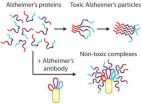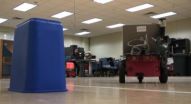(Press-News.org) When the dry lubricant, molybdenum disulfide, is stripped down to a single layer of atoms, a tightly bound quasi-particle comprised of two electrons and a hole forms with unique spin and valley properties, researchers from Case Western Reserve University and colleagues discovered.
These charged quasi-particles, called negative trions, can be manipulated to change the light absorbed and emitted from this two-dimensional semi-conducting crystal, opening it to potential use in new solar cells and other electronic devices that are controlled by light or designed to control light.
The discovery also opens up new opportunities to study what physicists call "many-body interactions"--in this case, the interactions among the charged particles--and a new concept of electronics called valleytronics.
The research is published in this week's online edition of Nature Materials.
"What we saw was something like a negative hydrogen ion–a positive charge bound to two negative charges," said Jie Shan, an associate professor of physics at Case Western Reserve and senior author of the paper.
The trions formed in the molybdenum disulfide crystal when the researchers applied a bias voltage on the back gate of a device called field-effect transistor. This was done at 10 degrees Kelvin, or -441 Fahrenheit. The electrons introduced by the bias voltage were linked to electron-hole pairs generated by absorption of photons, resulting in negatively charged trions.
"The interactions between charged particles in three-dimensional bulk materials are usually screened by the presence of other charges in the material. Because this material has an atomic thickness, the interactions between the charges are much stronger than in the natural bulk material due the drastically reduced screening," Shan explained. "The quasi particles are stable. Adding energy comparable to or larger than that of room temperature to the monolayer is required to break away the extra negative charge."
Because the trions are charged, they can be controlled by a bias electric field, Shan said. "This is very basic science; it is early, but this may offer a unique opportunity to use controllable and directional transport of optical excitation in a material, which could be useful for applications such as photovoltaics and optoelectronics."
Shan worked with her graduate student, Kelinang He, and, from Columbia University, Kin Fai Mak, a postdoctoral researcher, Tony F. Heinz, professor of physics and electrical engineering, Gwan Hyoung Lee postdoctoral researcher and James Hone, professor of mechanical engineering. Changgu Lee, an assistant professor of mechanical engineering at Sungkyunkwan University also contributed to the research.
The discovery of the trions increases the potential that this material can be used for valleytronics, the researchers say. Earlier this year, Mak, He, Shan and Heinz, and other research groups found they could control what's known as valley polarization–essential to valleytronics--in a single layer of molybdenum disulfide.
Conventional electronics rely on the control of the charge through materials. Spintronics use the spin degree of freedom of the charge carriers. Valleytronics rely on another property.
Because of symmetry, crystals frequently have independent, degenerate valleys in their energy bands. This so-called "valley" (or momentum) degree of freedom has been proposed as something that could be manipulated for new classes of electronic devices.
Using polarized light, Shan and fellow researchers were able to nudge electrons into a desired valley.
"The trions also show some interesting valley properties," Shan said. "But their valley lifetime may be very different, because it involves the interaction of three particles."
The researchers are continuing to probe the properties in a series of experiments.
### END
Uncovering unique properties in a 2-dimensional crystal
Potential for optoelectronics, solar cells, valleytronics and more
2012-12-03
ELSE PRESS RELEASES FROM THIS DATE:
Sharp spike in computer-related injuries predicted for medical workers, find studies
2012-12-03
ITHACA, N.Y. – As U.S. health care goes high tech, spurred by $20 billion in federal stimulus incentives, the widespread adoption of electronic medical records and related digital technologies is predicted to reduce errors and lower costs – but it is also likely to significantly boost musculoskeletal injuries among doctors and nurses, concludes a Cornell University ergonomics professor in two new papers.
The repetitive strain injuries, he said, will stem from poor office layouts and improper use of computer devices.
"Many hospitals are investing heavily in new technology ...
Cancer screening: The efficacy of mammography screening
2012-12-03
How effective is the German mammography screening program? This is the question examined by Oliver Heidinger of the Epidemiological Cancer Registry North Rhine–Westphalia and his co-authors in the first study on this subject in Germany, in Deutsches Ärzteblatt International (Dtsch Arztebl Int 2012; 109(46): 781-7).
To answer it, the authors have used the interval cancer rate as an indicator. Interval cancers are tumors found more or less by chance between two screenings. In approximately 880 000 women from North Rhine–Westphalia who had taken part in mammography screening ...
New 'pipeline' device offers new option for difficult-to-treat aneurysms
2012-12-03
Philadelphia, Pa. (December 3, 2012) – A new technology called the Pipeline embolization device (PED) shows encouraging results in patients with certain types of difficult-to-treat brain aneurysms, reports the December issue of Neurosurgery, official journal of the Congress of Neurological Surgeons. The journal is published by Lippincott Williams & Wilkins, a part of Wolters Kluwer Health.
Data collected since the PED was approved for marketing show generally good results in "real world" clinical practice. However, the report raises concerns about fatal bleeding and other ...
Novel antibodies for combating Alzheimer's and Parkinson's disease
2012-12-03
Troy, N.Y. – Antibodies developed by researchers at Rensselaer Polytechnic Institute are unusually effective at preventing the formation of toxic protein particles linked to Alzheimer's disease and Parkinson's disease, as well as Type 2 diabetes, according to a new study.
The onset of these devastating diseases is associated with the inappropriate clumping of proteins into particles that are harmful to cells in the brain (Alzheimer's disease and Parkinson's disease) and pancreas (Type 2 diabetes). Antibodies, which are commonly used by the immune system to target foreign ...
Awareness is key to preventing heat- and cold-induced athletic injuries
2012-12-03
ROSEMONT, Ill.—Extreme heat or cold can cause dangerous and potentially fatal side effects in athletes. A literature review appearing in the December 2012 issue of the Journal of the American Academy of Orthopaedic Surgeons (JAAOS) provides an overview of the risk factors, signs and symptoms, and management of various conditions related to excessive heat and cold exposure.
"Both extreme heat and cold can be challenging for athletes during training and competition," said lead study author Benjamin Noonan, MD, MS. "One role of the team physician is to educate coaches and ...
Squirrels and birds inspire researchers to create deceptive robots
2012-12-03
Using deceptive behavioral patterns of squirrels and birds, researchers at the Georgia Institute of Technology have developed robots that are able to deceive each other. The research is funded by the Office of Naval Research and is led by Professor Ronald Arkin, who suggests the applications could be implemented by the military in the future. The research is highlighted in the November/December 2012 edition of IEEE Intelligent Systems.
Arkin and his team learned by reviewing biological research results that squirrels gather acorns and store them in specific locations. ...
College students report low flu vaccine rate
2012-12-03
WINSTON-SALEM, N.C. – Dec. 3, 2012 – College football and basketball games may provide more than a way for students to show school spirit – they could help prevent the flu.
According to a new study by researchers at Wake Forest Baptist Medical Center, colleges and universities should implement new or improved influenza vaccine strategies, such as giving flu shots at sporting events or during campus-wide, day-long campaigns, to increase the number of their students who get the annual flu vaccine.
In the early online edition of the December issue of the Journal of American ...
PET imaging used to more accurately manage treatment, predict survival for patients with gliomas
2012-12-03
Reston, Va. (December 3, 2012) – In the management of gliomas—or tumors that originate in the brain—precise assessment of tumor grade and the proliferative activity of cells plays a major role in determining the most appropriate treatment and predicting overall survival. Research published in the December issue of The Journal of Nuclear Medicine (JNM) highlights the potential of imaging with 3'-deoxy-3'-F-18-fluorothymidine (F-18-FLT) positron emission tomography (PET) to noninvasively and accurately provide tumor-specific details to guide management of patients with gliomas.
Gliomas ...
Iron deficiency and cognitive development: New insights from piglets
2012-12-03
University of Illinois researchers have developed a model that uses neonatal piglets for studying infant brain development and its effect on learning and memory. To determine if the model is nutrient-sensitive, they have done some research on the effects of iron-deficient diets.
"Iron deficiency is a major problem worldwide," said Rodney Johnson, professor of animal sciences and director of the Division of Nutritional Sciences. "Infants who experience iron deficiency during the first 6 to 12 months of age can have irreversible developmental delays in cognition."
He ...
Dressing US troops to safeguard against insect attacks
2012-12-03
This press release is available in Spanish.Outfitting soldiers with clothing that effectively repels or kills insects is one of the strategies U.S. Department of Agriculture (USDA) scientists are using to help protect U.S. military personnel deployed overseas against disease-transmitting mosquitoes and sand flies.
As part of the Deployed War-Fighter Protection Research Program, scientists at the Agricultural Research Service (ARS) Center for Medical, Agricultural, and Veterinary Entomology (CMAVE) in Gainesville, Fla., and other ARS laboratories are collaborating with ...
LAST 30 PRESS RELEASES:
Velocity gradients key to explaining large-scale magnetic field structure
Bird retinas function without oxygen – solving a centuries-old biological mystery
Pregnancy- and abortion-related mortality in the US, 2018-2021
Global burden of violence against transgender and gender-diverse adults
Generative AI use and depressive symptoms among US adults
Antibiotic therapy for uncomplicated acute appendicitis
Childhood ADHD linked to midlife physical health problems
Patients struggle to measure blood pressure at home
A new method to unlock vast lithium stores
Scientists unveil “dissolution barocaloric” cooling, opening new path to zero-carbon refrigeration
Microplastics in the atmosphere: Higher emissions from land areas than from the ocean
Metal clumps in quantum state: Vienna research team breaks records
PolyU develops new human-safe magnetorheological fibres, leading innovations in smart wearable textiles
Rice establishes Global Brain Economy Initiative in Davos, aligned with new report on brain health and AI
Quantum error correction with logical qubits
Nutrient-stimulated hormone-based therapies: A new frontier in the prevention and management of MASH-associated hepatocellular carcinoma
Trauma or toxic? A deep dive into the impact of stress on kids' health
Turning industrial exhaust into useful materials with a new electrode
ORNL to partner with Type One Energy, UT on world-class facility to validate next-gen fusion
New journal section tackles AI, ethics, and digital health communication
Jeonbuk National University researchers develop novel dual-chemical looping method for efficient ammonia synthesis
New study sheds light on stroke recovery via exercise-induced migration of mitochondria
SEOULTECH researchers develop sodium-based next-generation smart electrochromic windows
Data-driven analysis reveals three archetypes of armed conflicts
Heart disease, stroke deaths down, yet still kill more in US than any other cause
Light switches made of ultra-thin semiconductor layers
Creative talent: has AI knocked humans out?
Sculpting complex, 3D nanostructures with a focused ion beam
A year after undermining Bredt’s rule, UCLA scientists have made cage-shaped, double-bonded molecules that defy expectations
Human activities drive global dryland greening
[Press-News.org] Uncovering unique properties in a 2-dimensional crystalPotential for optoelectronics, solar cells, valleytronics and more

